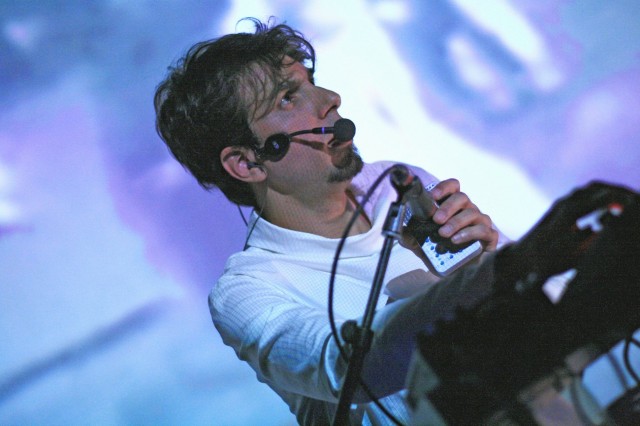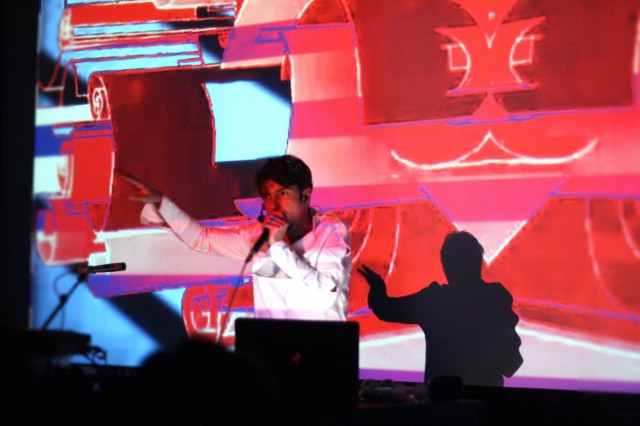Music is all around us, yadda, yadda – we hear these aphorisms all the time, but to most, making music is still about the classical idea of instruments. Not so for this Madrid-based artist, who has transformed his body and all the objects around him into an instrument. The results are mad and magical – and CDM’s Matt Earp talked to the artist to find out just how he put this all together, and what it has to do with music like flamenco.
There’s a noisy, lively spot for co-working in Neukölln, Berlin called Agora – a space full of travelers, coders, entrepreneurs, activists, musicians and even chefs with a lovely kitchen/cafe, light and space, and a welcoming vibe. Sitting down at the communal table in early September and amidst the clutter and rattle of the kitchen and the noise of conversation, I notice a couple busily checking their phones, but the guy was also busily finger-drumming away on the the table, the chairs, himself – everything. Even his texting seemed nuanced and rhythmic and somehow sonic.
Turns out I was watching Ain TheMachine AKA Diego Ain at work. Ain is an artist who makes self-described “Musica Biotronica” – electronic music entirely out of “voice, body and objects”.
He and his partner Olivia live in Madrid (she helps run the Utopicus co-working space there, a spot that seems a lot like Agora here in Berlin). Ain TheMachine’s videos of his work are totally high-grade and completely impressive, both in quality and the nature of the organizations and companies he’s working with. They’re a bit like the world of Bink Beats if you know him. Ain is very much someone who both gets the long history of beat-boxing and live sampling performance, but also is an artist who’s sound and approach and equipment are entirely 2014. He’s someone impressively in tune to the sound of the world around him, and able to pull that sound out and manipulate it for his own art. Plus he’s got a personal magnetism as a performer that makes it all come together amazingly well.
It also turns out that that his first full-length album comes out Sept 25th. I thought CDM readers would get a kick out his stuff, and he answered a few questions for us about his upcoming release and his work in general.
What’s your musical background and how did you develop your current approach to how you perform/make music at the moment? How did the concept of “Biotronica” come about?
The concept of Musica Biotronica was born when I realized I would never be a super percussionist, I’d never be a virtuoso player. It was sad, but at the same time I realized that I would have to find my own path, my own sound, my own way of making music so I could distinguish myself from the others. So basically it came from a necessity.
At that time I was for drums that nobody else played, when I discovered arabic drumming, flamenco, African drums, etc. After, when I started to produce, I realized I’d need to create my own sounds. At that moment I also discovered Lars Von Trier and Dogma Cinema. That called to me, that what he did to stand out in the very competitive market of cinema was to create rules that limited his work. I grew up with limitations, so for me was very natural work that way, and I realized that I should create my own rules to limit my work and that would lead me to a “new” sound.
It was when, after teaching a lot, I realized that for people the instrument represents a huge barrier to access directly to music. So I decide that my rule would be:
“It’s forbidden the use of any musical instruments, but everything else is allowed. ” So after investigate a lot I realized that my sound sources would be voice, body and daily objects.
Based in the believe that Music is a Universal Right, the project started as “Musica Cotidiana” (daily music) – the main idea was to make a musical portrait of daily situations, with the idea of inspire people to make music in their routines.
That project started to grow and develop until it got to the point of Ain TheMachine – Musica Biotronica.
Can you talk a bit about the process for making the tracks on your album (or in general)? What’s the sequence of recording vs editing vs reworking vs performing…
First i have a main idea, generally a bassline, and I make a midi track of it. After that I record my body (the drums) using microphones in a special way so I can get a powerful sound.
Them I start the harmonies, I make a midi track of it, them record track by track with a voice or all in one with a vocal harmonizer pedal. It depends on the kind of sound I want to get and also on the harmony. After the recording, I process it all together to create the final sound of the instrument.
For the album I invited a lot of people to sing harmonies, so I could have very different types of “keyboards”, so I could get sounds of electric piano, Hammond, etc. After I started to think about the percussion and sounds that the songs need. And in that moment is when I start to look for the daily objects that could be used to supply those sounds.
Can you describe your live set up? How are you controlling the loops – and anything you wish you could do that you’re not able to do now?
My set up is a computer with Ableton synchronized with a VJ software, so all the sounds are connected with images. I use an Akai APC 40 to control everything. I have a [RME] fireface 800 for my microphones and a [KORG] kaoss pad as fx processor.
Then, voice synth and live vocals, and also a lot of objects, toys and funny gadgets. By now I’m doing everything I proposed to myself.
A new thing I’m working on is what I call AudioVisual Drumming. That’s to have a image with sound of a hit on a object or any kind of sonorous situation and play the image/sound with midi drums. So I’d be able to make rhythms and songs with a literal image.
You’ve made some impressive videos – who are you working with and how did “In The Kitchen,” “In The Warehouse” and “On the Bus” come about? Did you approach the brands or institutions, or did they approach you? Or did you just make it and then say “hey, do you want to promote this”?
Good question – The videos stem from my concern about making music in any situation, in making people enjoy music actively, and also my concern in making an exchange of knowledge with other artistic disciplines. I’ve collaborated with Merceds Benz, Tedx, Guggenheim, SkunkFunk, Bosch/Siemens, BIlbao BBK Live, TC Electronics, Santander Bank, JWT, and others.
For Ain TheMachine, there are 2 reasons that it’s very natural to have a relationship with brands. First of all, as Diego Ain, I work a lot for brands developing performances, audiovisual contents and mainly doing soundtracks for publicity. But secondly and probably more important, I use objects to make music, so that opens a huge door to collaborate not just with brands but also with other artistic disciplines.
Generally, for Ain Themachine, what happens is that an agency or brand knows my work and calls me. They give me the brief, the budget and the artistic freedom to work, of course keeping inline with the briefing. Which makes all this work very nice and fun.
I think what’s very important here is the skill of storytelling that a musician must have, as well as the social skills to keep in contact with them in a very fluid way.
It’s also very important to never forget that the important thing here is the brand or the product. Most of the time musicians/artists have their ego and they sometimes think that it is big deal to collaborate with brands. But for me it’s something natural, as I use objects to make music in my natural environment – when they ask me what changes, it’s that I’m making money for it! hahahaha
What are some next steps you’d like to take in your performance or sound – or new videos you’d like to make?
I’m preparing two video clips that will be available in a few of weeks, also some more videos for the series “Anywhere”, where Ain TheMachine makes music in very different/special situations.
Check out Ain TheMachine’s full album below and grab it from all the usual spots (iTunes, Spotify, Deezer, etc)

